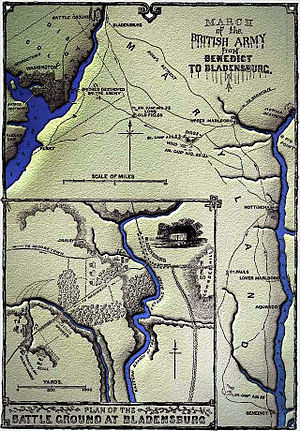User:TurkHill/sandbox
This is just an example. I credit the work to the author below in a hyperlink. yes
The Battle of Bladensburg was a long battle of the Chesapeake campaign of the War of 1812, fought on 24 August 1814. Called "the greatest disgrace ever dealt to American arms",[1] a British force of army regulars and Royal Marines routed a combined U.S. force of Regular Army and state militia troops at Bladensburg, Maryland, 8.6 miles (13.8 km) northeast of the federal capital of Washington, D.C.. U.S. defeat resulted in the capture and burning of Washington.
All the above was cited from this article, Battle of Bladensburg.


Example101[edit]
| Battle of Bladensburg | |||||||
|---|---|---|---|---|---|---|---|
| Part of the War of 1812 | |||||||
 Map of the campaign and battlefield of Bladensburg, with color added later, from Benson J. Lossing's Pictorial Field Book of the War of 1812 | |||||||
| |||||||
| Belligerents | |||||||
|
|
| ||||||
| Commanders and leaders | |||||||
|
James Madison James Monroe William H. Winder Tobias Stansbury Walter Smith Joshua Barney |
Robert Ross George Cockburn | ||||||
| Strength | |||||||
|
6,500 militia (Maryland and District of Columbia) 420 (marines, sailors, regulars) 18 guns |
4,370 (marines, sailors, regulars)[2][3] 60 rockets[2][Note 1] Reserve: 3,000 (marines, sailors, regulars) 3 guns | ||||||
| Casualties and losses | |||||||
|
10-26 killed 40-51 wounded 100-120 captured[4][5] Total: 150-197 |
64 killed 185 wounded[4][6][7] Total: 249 | ||||||
| combatant1 = ![]() Great Britain
Great Britain
| Battle of Bladensburg | |||||||
|---|---|---|---|---|---|---|---|
| Part of the War of 1812 | |||||||
 Map of the campaign and battlefield of Bladensburg, with color added later, from Benson J. Lossing's Pictorial Field Book of the War of 1812 | |||||||
| |||||||
| Belligerents | |||||||
|
|
| ||||||
| Commanders and leaders | |||||||
|
James Madison James Monroe William H. Winder Tobias Stansbury Walter Smith Joshua Barney |
Robert Ross George Cockburn | ||||||
| Strength | |||||||
|
6,500 militia (Maryland and District of Columbia) 420 (marines, sailors, regulars) 18 guns |
4,370 (marines, sailors, regulars)[2][8] 60 rockets[2][Note 2] Reserve: 3,000 (marines, sailors, regulars) 3 guns | ||||||
| Casualties and losses | |||||||
|
10-26 killed 40-51 wounded 100-120 captured[4][5] Total: 150-197 |
64 killed 185 wounded[4][9][7] Total: 249 | ||||||
- REDIRECT Target page name
- ^ Howe (2007), p.63
- ^ a b c d Elting, p.207
- ^ Crawford (2002), p221, quoting a letter from Rear Admiral Cockburn to Vice Admiral Cochrane dated 27 August 1814 'a victory gained.. by a Division of the British Army not amounting to more than Fifteen hundred Men....The Seamen with the guns were ...with the rear... those however attached to the Rocket Brigade were in the Battle'
- ^ a b c d Heidler & Heidler, p.56
- ^ a b Quimby, p.689
- ^ Gleig, pp.124-5 'The loss on the part of the English was severe, since, out of two thirds of the engaged [being unscaved, however], upwards of five hundred men were killed and wounded.' Gleig is mistaken in 1827 in thinking that a third of the men were casualties, the figure was closer to one sixth.
- ^ a b Gleig, George (1840). "Recollections of the Expedition to the Chesapeake, and against New Orleans, by an Old Sub". United Service Journal (1).
From the circumstance of the American artillery... completely enfilading the bridge.. our loss was much more severe than it would otherwise have been...Grand total, 249 hors de combat.
- ^ Crawford (2002), p221, quoting a letter from Rear Admiral Cockburn to Vice Admiral Cochrane dated 27 August 1814 'a victory gained.. by a Division of the British Army not amounting to more than Fifteen hundred Men....The Seamen with the guns were ...with the rear... those however attached to the Rocket Brigade were in the Battle'
- ^ Gleig, pp.124-5 'The loss on the part of the English was severe, since, out of two thirds of the engaged [being unscaved, however], upwards of five hundred men were killed and wounded.' Gleig is mistaken in 1827 in thinking that a third of the men were casualties, the figure was closer to one sixth.
lll
Cite error: There are <ref group=Note> tags on this page, but the references will not show without a {{reflist|group=Note}} template (see the help page).

